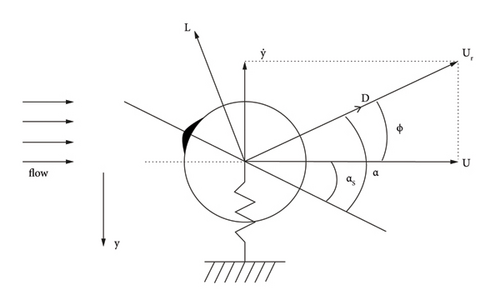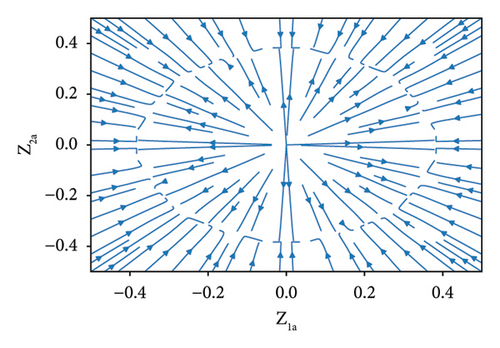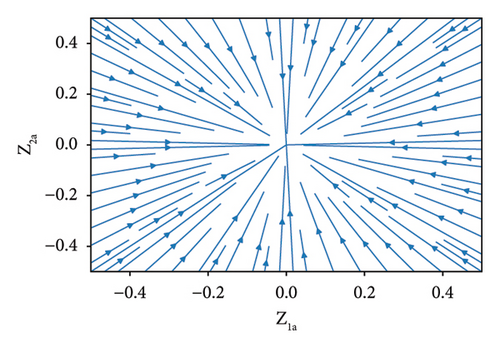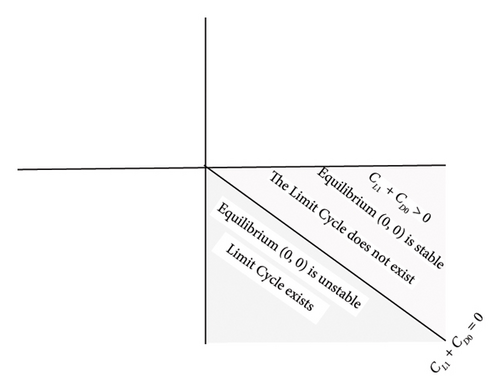Limit Cycle on the Forced Vibrations Oscillator with a Time-Varying Mass
Abstract
In this paper, a forced vibration caused by drag and lift forces with time-varying mass is studied. The construction of the model is conducted by adding impact force to the previous model. The periodicity of the solution is yet known. Hence, the model is seen as a perturbation problem. Since the unperturbed problem has a periodic solution, we applied the averaging method to determine the sufficient condition such that the limit cycle exists.
1. Introduction
Vibration is a dynamic phenomenon that is quite complicated. In particular, the stability of a system that experiences vibrations is usually challenging to determine; however, it is essential to know. In engineering, numerical approaches and experiments are used to determine the system’s state experiencing vibrations. Nevertheless, theoretical studies of this phenomenon are also widely carried out by scientists since they are expected to provide a better approximation.
One of the essential problems to be studied is the vibrations in bridge cables due to rainwater and wind. Raindrops that fall on the bridge cable will remain on the line until a certain mass and then fall, dripping. This fact repeatedly happened until the rain stopped. The fluid forces are divided into two components as follows: drag force in line with the flow direction and lift force perpendicular to the flow direction [1]. If the mass of raindrops and rainfall is assumed to be equal, then there is no change in the total mass, so the mass is constant. Under this assumption, the mathematical model that describes a vibration of cables in a vertical direction was studied by Haaker and van der Burgh in [2]. Moreover, the authors assumed that the vibration force is affected by the angle between the symmetric axis and the horizontal wind velocity or used to call a static angle of attack. Under this assumption, the authors could present conditions for the existence and uniqueness of a stable limit cycle. If Den Hartog’s criterion applies, the linearized equation in [2] has an unbounded solution.
The phenomena of rain-wind induced vibration because of occurrence of the rivulet of water in the inclined cable. An inclined cable is aerodynamically stable without rain but unstable with rain. The experimental data showed that the rivulet of water and the angle of the wind to the cable could make vibration phenomena [3].
A different assumption was studied in [4] associated with the variation of the position of the water ridge. The authors assume that it depends on time, i.e., a periodic function with a nonzero initial value using the cosines function. In contrast with the result in [2], the linearized equation in [4] leads to periodic solutions. A more detailed explanation was presented in [5]. Another assumption was also presented by Waluya in [6]. He studied the dynamic of the cable-stayed bridge as in [4] using the assumption that the variation of the position is a periodic function with zero initial value using the sinus function. Using the perturbation technique, he presents the approximation of the solution for different cases of angular frequency. All these references assume that the mass is constant, whereas in this case, it makes more sense if the masses are unbalanced.
Studying the dynamics of oscillator systems whose mass varies with time is essential for many mechanical and astronomical systems problems. Irchik and Holl in [7] provided a complete bibliography with references to the application problem in various areas such as biomechanics, robotics, conveyor systems, and many others. Wisdom et al. mentioned in [8] that in celestial mechanics, the issue of mass varies very closely concerning the planar oscillations of a satellite. Moreover, in solid and fluid mechanics, the main principle of mass conservation may be incompatible with many mechanical systems that release or capture material with a particular mechanism. Numerous studies about the vibration related to external force and time-varying mass with numerical and analytic approaches have been carried out (see, for instance, [9–13]).
General formulation of the variable-mass system was presented in [7] by considering the velocity of the impacting mass while deriving the time-varying mass model. Numerous studies were then carried out using the results of this study. van Horssen et al. in [14] provided a mathematical analysis of the stability region for a free vibration force and zero velocity, with the ratio of the time-varying mass of the raindrops and the mass of the oscillator as a periodic step function. Waluya in [15] assumed that the ratio is a periodic sinusoidal function. A year later, further analysis was conducted in [16, 17] by adding vibration force as a harmonic force.
A new model of the vibrations in bridge cables due to rainwater and wind was redeveloped in [18], taking into account that the system’s mass is no longer constant. The total mass (cable and water) changes periodically. The mass increases when water attaches to the cable and decreases when water drips from it. Thus, in this system, the mass varies with time. However, this model still does not involve the velocity of the impacting mass. Therefore, this research will improve the model in [18] by involving the velocity of the impacting mass. Later, the dynamic of the forced vibrations oscillator is studied. One of the important discussions in system dynamics is related to the existence of a limit cycle.
The aim and novelty of this research is to study the oscillation behaviour of the cable, seen from the existence of a limit cycle. The existence of the stable limit cycle can be interpreted that the vibration of the structure is periodically. This paper is organized as follows. Section 1 discusses the urgency of this research. Section 2 contains the method of research. Section 3 constructs a model involving mass variation and velocity of impacting mass. Section 4 analyzes the existence of limit cycles. Last, Section 5 concludes and formulates future research.
2. Method of Research
The averaged system (2) should be simpler to analyze, and its properties should reflect the dynamics of system (1); see [19]. The final step is to analyze the averaged equation to get the limit cycle and bifurcation.
3. Forced Vibrations Oscillator with a Time-Varying Mass Model
A mathematical model that describes the rain-wind-induced vibrations of a straightforward one-degree-of-freedom system associated with the dynamics of cable-stayed bridges will be developed in this section. The model is an oscillator with a single degree of freedom that consists of a solid-state ridge travelling in a horizontal stiff wire (cylinder) supported by springs [6, 19]. A portion of the raindrops that hit the cylinder will stay on its surface for a while before being blown or shaken off later. This phenomenon could cause aerodynamic instability in vibrations. Hence, in this system, we consider a force vibration influenced by an external force, later called an aerodynamic force.

In the next session, we formulate the sufficient condition for the existence of the limit cycle of equation (16). The limit cycle for a mass constant has been discussed in [2]. The corresponding model can be transformed into a Liénard system. Hence, the existence of a stable limit cycle is guaranteed using the existence theorem by Dragilev as cited by Ye et al. in [22]. Nevertheless, problem (16) is a perturbation problem that cannot be transformed into a Liénard system. For , the unperturbed problem has a periodic solution. Therefore, we use a perturbation method called the averaging method.
4. Existence of the Limit Cycle
Verhulst in [19] identified the existence of a periodic solution of a weakly nonlinear nonautonomous equation for a harmonic oscillator using the Poincare theorem. Since the periodicity of the solution is yet unknown, the existence of a limit cycle in this system will be evaluated from its averaged equation.
The determinant is not equal to zero for all values of parameters except . Thus, it is reasonable to conclude that there exists a limit cycle around the equilibrium point (0, 0), and the stability of the limit cycle follows the stability of equilibrium points (0, 0). Thus, for condition , the limit cycle is unstable and for condition , the limit cycle asymptotic stable as well as the equilibrium points. Moreover, if the equilibrium point is unstable, then a limit cycle occurs. The illustration can be seen in the figure phase portrait of the averaged system (26) for rU/ky = 1 and (see Figure 2).


In addition, Figure 3 shows the bifurcation diagram of and parameters. The bifurcation domain occurs only in region when and . The limit cycle appears when , and the equilibrium point is unstable. In contrast, the equilibrium point is stable when .

5. Concluding Remarks
In this paper, we approximate the nonlinear part of aerodynamic force using Taylor expansion, particularly for case αs = α0. The system was transformed according to the variation parameter method. The result showed that by implementing the averaging method for a new system, the determinant of the Jacobian matrix near equilibrium (0, 0) is nonzero. Therefore, the limit cycle exists. The stability of equilibrium points depends on the sign of . For future research, it is interesting to study for ω = 1 + εβ. In addition, the research will be more attractive when the model is a two-dimensional case with nonlinear terms (not weakly nonlinear).
Conflicts of Interest
The authors declare there are no conflicts of interest.
Acknowledgments
This research was funded by DIPA Universitas Negeri Yogyakarta in the context of implementing the Research Group Program 2019, no. B/3/UN34.13/HK.06.00/2019.
Open Research
Data Availability
No data were used to support the findings of this study.




